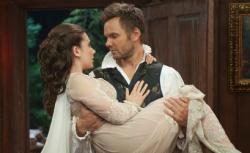Two weeks ago, the bravura episode called “Remedial Chaos Theory” demonstrated that Community, the Thursday night sitcom on NBC, remains the smartest, weirdest show on TV. Based on showrunner Dan Harmon’s own experience at community college, the show is now in its third season. In the premiere, the show’s hero (and Harmon stand-in) Jeff, a pretty-boy disgraced lawyer, forms an imaginary study group to get into the pants of high-strung hottie, Britta—only to find, to his chagrin, an actual study group forming around him. The other members include Aspergers-afflicted Abed, who views the world through the prism of pop culture; former high-school football star Troy, Abed’s BFF; Shirley, a mother of two; Pierce (played by Chevy Chase), a wealthy retired guy who for some reason goes to community college; and a younger woman, Annie, a goodie-goodie with a well-cloaked voluptuousness.
The show is deliberately constructed so that Harmon and his writers can drape complex and unrelenting TV-sitcom tropes and pop-culture references all over its scaffolding. The varied ethnicities and demographics of the characters, for instance, both remind us of and explode typical TV tokenism. The deliberately insular setting of the study room pays homage to the bar from Cheers and the apartment and diner from Seinfeld.
The show then sets the pop-culture-reference blender to puree—with the corresponding postmodern overtones of meaninglessness and insubstantiality—but still tries to maintain the humanity and depth of the characters. In a weird way it basically succeeds. (Back in August, I wrote a piece about the show’s most elaborate conception to date.)
Last night’s episode was once again deeply conceived, complex, and multilayered. (How this poorly rated, Emmy-scorned shows pulls this off budget-wise is a mystery.) It’s Halloween; the episode’s title is “Horror Fiction in Seven Spooky Steps.” There’s a serial killer loose in the study room! Sorta. Our host, and the focus of the show, is brittle Britta, intellectually disheveled as always, now a wannabe psych major.
She’s been going over the anonymous psychological questionnaires she to everyone in the study group and is dismayed to discover that one of her friend’s answers suggest someone who is deeply, perhaps homicidally, disturbed. Our killer, in other words, is something of a simulacrum—and the mystery’s solution turns out to be as well, in a Murder on the Orient Express kind of way. So, as the school’s Halloween party unfolds in the background, she asks the seven members of the study group to tell scary stories, which she can then examine for signs of psychological disturbance.
Particularly in the wake of “Remedial Chaos Theory,” this episode felt more labored than most. Each character tells a different scary story, and these become minifilms acted out in different horror-genre styles, with the cast members playing the various parts in each one. These were a bit samey and lacked the eerie surprises you expect from a Halloween episode. (It certainly can’t compare to the zombie Halloween episode of last season.)
The minifilms do deconstruct the horror-movie genre, though. The first target, in Britta’s tale, is the utter implausibility of most horror-movie scripts, particularly the woodenly self-destructive actions of their characters. Then we get the flip side: a story by the implacable Abed featuring unfailingly logical actions by the characters that turns out to be a colossal bore. The following stories nod to the medical-experiment genre, the exploitation film, the vampire tale, and so forth, each one warped by the narcissistic psychological baggage of the tale-teller. (Innocent Annie’s is an appropriately indistinct mélange of Elizabethan bodice-ripper and True Blood, climaxing with a meticulously described dismemberment, and digestion, of Jeff, told with just a bit too much relish.)
The manic, cross-dressing Dean Pelton has a couple of appearances, too, notably as the devil in one bloody morality tale. Pelton, incidentally, is played by Jim Rash, who this season has his name in the opening credits*—which also serves as a great pun, given the show’s school setting. (Rash is a screenwriter, too; an adaptation he co-wrote of the novel The Descendants for an upcoming Alexander Payne movie may become Oscar fodder this year.)
Since the horror movie in all of its guises is the main concern of the narrative, a lot of the usual pop-culture references of the show get shoved out. There is room for a couple of NPR nods, though. My favorite was Britta talking about a podcast she had on her computer: “I have Michele Norris interviewing Errol Morris. Don’t worry, they address it.” I can’t quite conjure up the sources of Tory’s and Abed’s costumes; they are each vaguely Little Tramp-ish, but Abed has a Harpo Marx thing going on in a bathrobe with a bowler and Troy is in a baggy, Keystone Kops-y uniform.
What did you think the costumes were? And what else did you notice in this episode?
Let me know. More next week.
Correction, Nov. 2, 2011: This piece originally stated that Jim Rash’s name first appeared in the opening credits in the Halloween episode. Rash’s name has appeared in the opening credits throughout Season 3. (Return to the corrected sentence.)
